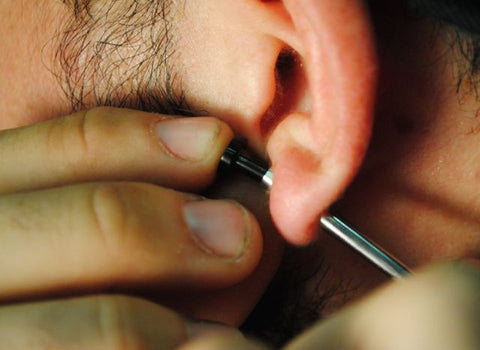To Taper or Not to Taper? (pt. 2)

Last week, we talked about the recommended methods for sizing up while your piercings are below 00 (10mm). If you’re under 00, click here to read our recommendations for safe and healthy tapering.
This week we’ll be helping out those of you who have moved on to bigger sizes and are unsure of the best/easiest/safest way to go about it. While tapering is a great option for smaller sizes, it’s actually not the preferred method beyond 10mm as the jumps between sizes will grow higher and higher.
So, just what is the recommended method? Taping!
What you’ll need
Obviously, you’re going to need tape. In our experience, the absolute best tape you can use is Bondage Tape, which is actually designed for safe contact with human skin. (Plumber’s tape will also work for stretching, though the preferred method is still Bondage Tape. Just make sure that you do not use electrical tape.)

Bondage Tape.
You’ll also want to get plugs in your next size up. We recommend using Single-Flare Steel Tunnels for two reasons. One, steel is the most sanitary material for stretching. And two, the non-flared backs of the tunnels will make it much easier to fit them in your ears without danger to your lobes. It’s also a good idea to get your hands on some Ear Butter for this transition to take good care of your skin, prevent scar tissue, and keep things nice and sanitary.

A pair of single-flared steel tunnels.
What to do:
Remove your current plugs and wrap the wearable area with the tape. Start by using a single layer and see how that fits in your ear, and if it goes in super easily, feel free to add another layer or two. The idea is for it to stretch your ears a little bit, but not too much. Because you’ll only be stretching in tiny increments, you can add more tape every day or two. Just make sure to take it slow and listen to what your body is telling you. Everyone’s ears are different!

Ear butter: Nectar of the gods.
Once you’ve managed to get your plugs to the next size up, it’s time to put in your new tunnels! Remove your taped-up plugs, and make sure your ears are nice and clean. Add some Ear Butter to your lobes to ease the transition, and insert your (sterilized) Single Flare Steel Tunnels by slipping the non-flared ends through your lobes.
Remember:
Tearing, infections, scar tissue, and blowouts are not worth it and easily avoidable! Keep it clean and take it slow! If you cause yourself to tear or bleed, go back down to your previous size and let things heal up before moving up! We always recommend 6 weeks for full healing between sizes. Believe us, having healthy and good-looking lobes is totally worth the wait!
Only YOU can prevent blowouts!










